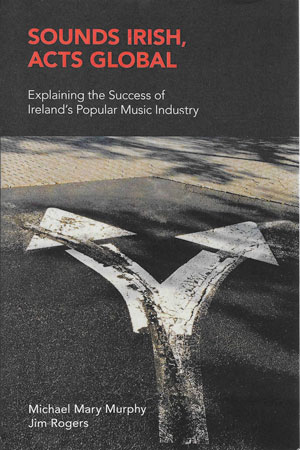
MICHAEL MARY MURPHY and JIM ROGERS
Equinox Publishing
£70
ISBN 9781781797808
REVIEWED BY Donal Fallon
Donal Fallon is the presenter of the ‘Three Castles Burning’ podcast.
It may terrify some readers to read that the LPs that defined their teenage years are now being mulled over by historians and sociologists. In recent years, studies like Seán Campbell’s Irish blood, English heart: second generation Irish musicians in England and Stuart Bailie’s excellent Trouble songs: music and conflict in Northern Ireland have explored genres like punk, new-wave and indie rock through a historical and sociological lens that has placed various youth cultures in their broader context. The 40th anniversary of the Clash gracing Trinity College’s Examination Hall even warranted a full-day symposium in 2017.
Sounds Irish, acts global brings something new to the growing body of work around popular music by focusing not on the music itself but instead on its commercialisation, management and promotion. Across thirteen chapters, this study seeks to tease out the reasons for the success of Irish popular music internationally. Its very first sentence outlines an important distinction: ‘This is not a history book, at least not in the conventional sense’.
Much of the collection comes from Michael Mary Murphy, with Jim Rogers contributing the longest chapter in an important overview of the global music industry and Ireland that does much to give the reader a sense of the existing literature that conceptualises the subject. Both Murphy and Rogers bring their own insights to the study shaped by research, but in Murphy’s case more than twenty years as an artist manager within the music industry brings lived experience to the collection. Readers of Murphy’s Village magazine articles, which provided great historic snapshots of acts from the margins like Stano and the Radiators From Space, will be aware of the depth of his musical knowledge—but this study is primarily about those on the other side of the sound desk.
The music industry, Rogers tells us, ‘is conventionally understood as an umbrella term encompassing three core sectors of enterprise: the recording industry, the music publishing industry, and the live music industry’. These sectors have all interacted with Irish popular music in ways that are universal, but also—owing to political and social circumstances—in ways that are unique to this island.
Early chapters provide an important historical overview on how the music industry developed elsewhere (we learn that Irish America played a vital role in that, embodied in the success of John McCormack), before studying post-independence popular culture in Ireland broadly. While Murphy points out that records were not subjected to the same censorship as films or literature, he also draws attention to the 1930s Public Dance Halls Act and the cultural atmosphere more broadly, noting that ‘the overzealous policing of dancing in Ireland had a major consequence. It stunted the growth of the domestic music industry.’
With emphasis here on management and promotion, chapters on acts like Boyzone and Westlife can lead to more surprising places. If U2 were a ‘band of four but a corporation of five’, as Paul McGuinness quipped, Louis Walsh was the dominant figure over Irish pop, with Murphy rightly noting how ‘Walsh used his time in the Irish showband/cabaret scene to develop the skill set and acumen that made him prosper in the 1990s media terrain’. On the subject of showbands, one defining feature of that earlier scene was its cross-border nature. In his memoir, Albert Reynolds (a figure curiously absent here) recalled how ‘the same showbands were as popular in Belfast as they were in Bantry. It was an all-Ireland phenomenon and a uniquely Irish business.’ References to Northern Ireland are rare in this study, but it is a subject that would have been interesting to explore. How did the music industry differ in promoting certain acts north and south, and what did the conflict mean for the live music industry?
Refreshingly, the study affords space not only to the key players in the corporate world of music management and promotion but also to those of a DIY ethos. If large parts of this study are about the relationships between music and capitalism, then its examination of the Hope Collective, founded by Niall McGuirk, is a study of the very opposite. Bringing acts like Fugazi and a young Green Day to Dublin, Hope was a not-for-profit concern, organising concerts exclusively for groups from the margins. ‘We had nothing against bands on major labels’, McGuirk insisted, ‘but they had lots of people working for them, so why should we help them?’ What follows is a fascinating potted history of a collective which, we’re told, ‘did not have a venue of its own, [so] made a series of unlikely alliances with a range of venues run by veterans of the Irish music scene, a biker gang, the semi-state bus company, the Communist Party, local colleges and universities, as well as both the Church of Ireland and the Catholic Church’. It is perhaps testament to how the mainstream music industry misses nothing that many of the acts that McGuirk brought here were later signed to major labels. Green Day went to Warner, and even the decidedly anti-capitalist Chumbawamba would ride high up the charts with Universal.
This collection does much to increase our understanding of popular Irish music, and ultimately challenges a long-standing myth that has plagued Irish creatives of all kinds: that one must leave Ireland to be discovered. Instead, it is clearly demonstrated that ‘artists benefit from local assistance before they engage with major global firms’. All global success stories begin locally, be it U2 in the Project Arts Centre or Westlife in Sligo’s Hawks Well Theatre.
